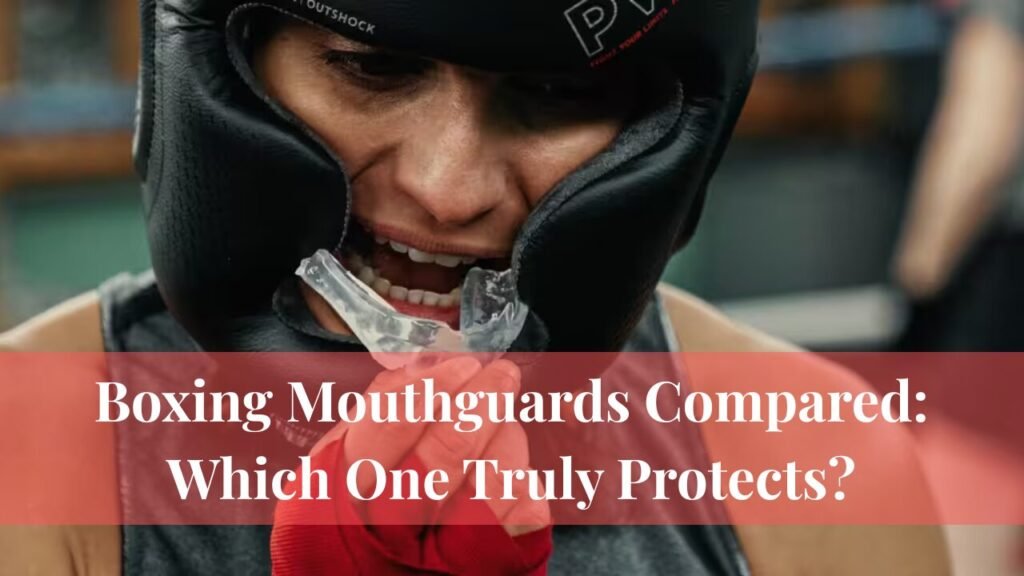A punch to the face isn’t just painful; it can cost a fighter their teeth, jaw stability, or even their career. That’s why choosing the right boxing mouthguard is just as essential as selecting high-quality gloves or headgear. The mouthguard serves as the first line of defense against oral injuries, concussions, and even fractured jaws. With dozens of brands claiming to offer the best protection, it can quickly become overwhelming to pick the right one for your needs. Making an informed choice requires understanding the different types of mouthguards, comparing top-rated models, and selecting the one that matches your level of training, budget, and intensity in the ring.
This comprehensive guide will equip you with everything you need to know to make a safe, effective, and informed choice, ensuring your teeth, jaw, and overall oral health remain protected during both training sessions and professional bouts. By following the recommendations here, you can make a selection backed by expert insights, professional advice, and user experiences from across the boxing community.
Types of Boxing Mouthguards
Mouthguards are not one-size-fits-all. They vary significantly in fit, cost, durability, and the level of protection they provide. Understanding the different types available can save you from purchasing a guard that is ineffective or uncomfortable.
Stock mouthguards are pre-formed and readily available in most sports stores. They are inexpensive and convenient, making them an easy option for casual use. However, these guards tend to be bulky and cannot be adjusted to the individual wearer’s teeth, which often leads to a poor fit and minimal protection. Stock mouthguards are a decent short-term solution for complete beginners but are generally not recommended for anyone who trains regularly or participates in competitive bouts.
Boil-and-bite mouthguards are made from thermoplastic material. They are softened in hot water, allowing the user to mold them to their teeth for a moderately snug fit. These mouthguards are more affordable than custom-fit options, generally costing between $10 and $30, and they offer adequate protection for amateur fighters. Their dual-layer construction often includes an inner gel lining, providing a better fit and some cushioning against impact. Boil-and-bite guards are popular among beginners and light sparring enthusiasts because they balance comfort, cost, and protection effectively.
Custom-fit mouthguards are crafted using dental impressions taken by a dentist or specialist. These guards provide the best possible fit and protection and are often used by professional boxers and serious athletes. They can range in price from $100 to $500, but their benefits far outweigh the cost. Custom-fit mouthguards distribute impact forces more evenly, reduce the risk of concussions, and allow for better breathing and speaking during fights. For anyone who competes seriously or trains at a high intensity, custom-fit options are considered the gold standard in boxing safety gear.
What Makes a Good Boxing Mouthguard?
When evaluating boxing mouthguards, certain critical factors should guide your choice. Fit is paramount; the mouthguard should stay in place without requiring constant biting down. Comfort is equally important, as a poorly fitting guard can interfere with breathing and speaking, diminishing both performance and safety. Protection is another major consideration. Mouthguards with multi-layered designs or shock-absorbing materials provide superior defense against impact. Durability ensures the guard can withstand repeated use without losing shape or functionality. Breathability also plays a role, as ventilated designs improve airflow and allow for easier oxygen intake during cardio-intensive sessions. Finally, certification matters. Look for products with CE markings or FDA approval to ensure that the mouthguard meets safety standards established by regulatory authorities.
Top Boxing Mouthguards Compared
Several brands stand out in the market for their quality, comfort, and reliability. OPRO Power-Fit mouthguards, for instance, are a custom-fit option widely used by professional athletes. They are officially licensed by organizations like the UFC and England Boxing. The dual-layer construction and flexible inner cage provide exceptional shock absorption, ensuring that force is evenly distributed to minimize the risk of injury. Reviews consistently highlight their comfort, fit, and protective capability, with a rating of 4.8 out of 5 from over 1,200 users.
The AQF Gel-Fit mouthguard is a popular boil-and-bite model, particularly suitable for amateur boxers. Its dual-layer construction and inner gel lining offer a reasonably secure fit for light to medium sparring sessions. While it is more affordable, typically costing between $10 and $15, it provides adequate protection for new fighters. The comfort and adjustable fit make it a reliable choice for those beginning their boxing journey.
Shock Doctor Gel Max mouthguards are another highly recommended option. They require a boil-and-bite procedure to achieve a snug fit and feature a triple-layer design with a shock frame and gel-fit liner. This construction balances affordability and effectiveness, offering substantial protection for sparring and regular training sessions. With a mid-range price of $15 to $25 and positive reviews from over 900 users, the Gel Max is a versatile choice for both beginner and intermediate fighters.
Real User Experiences
Many boxers emphasize the importance of upgrading to high-quality mouthguards after experiencing their first facial injury. Cheap, ill-fitting guards are prone to slipping during sparring, significantly increasing the risk of injury. One semi-professional fighter recounted his experience, explaining that he used a basic boil-and-bite mouthguard early in his training. After suffering a minor concussion due to a poorly absorbed punch, he switched to a custom-fit model. The difference in comfort, stability, and protection was remarkable, transforming his training experience.
Gym owners also report that fighters who consistently use properly fitted mouthguards perform better and experience fewer injuries. These real-world insights reinforce the notion that investing slightly more upfront in a quality mouthguard is a smart decision, offering both health benefits and long-term financial savings by avoiding costly dental repairs.
How to Choose the Right Mouthguard for Your Needs
Selecting the ideal mouthguard requires careful consideration of several personal factors. Beginners can safely use well-made boil-and-bite options like the AQF Gel-Fit, which provide solid protection without a significant financial commitment. Serious athletes and competitive boxers should consider investing in custom-fit guards like the OPRO Power-Fit, which offer superior comfort, fit, and impact absorption. Other factors to consider include whether you wear braces, the frequency of your training sessions, your budget, and whether you require a breathable design for cardio-intensive routines. Making the right choice ensures optimal safety, performance, and longevity of the mouthguard.
Maintenance and Hygiene Tips
Even the highest quality mouthguard will not provide adequate protection if it is not properly maintained. After each use, it is essential to rinse the guard thoroughly with clean water. Regular cleaning with toothpaste or mild soap on a weekly basis can prevent bacterial buildup, which is crucial for oral health. Mouthguards should never be left in direct sunlight or extreme heat, as this can cause deformation. Using a ventilated case helps prevent bacterial growth and keeps the guard dry and ready for use. To maintain maximum protection, replace your mouthguard every six months or immediately if you notice any signs of wear or deformation. Research indicates that poorly maintained mouthguards can harbor bacteria, leading to oral infections, bad breath, and sore throats, which can affect both health and athletic performance.
Professional Recommendations
Dental experts and sports medicine practitioners consistently recommend the use of well-fitted mouthguards for athletes in contact sports. According to the American Dental Association, athletes not wearing mouthguards are 60 times more likely to sustain dental injuries. Custom-fit options, while more costly, provide unparalleled protection against tooth fractures, jaw dislocations, and concussions. These insights are echoed by professional boxers and amateur competitors alike, who prioritize dental-grade gear to minimize the risk of injury and enhance in-ring performance.
FAQs
What type of mouthguard is best for boxing?
Custom-fit mouthguards are ideal for advanced protection, while boil-and-bite options work well for beginners.
Can you wear a mouthguard with braces?
Yes, several brands like Shock Doctor and OPRO offer braces-compatible models.
How often should I replace my mouthguard?
Every 6 months or sooner if you notice wear and tear or changes in fit.
Are mouthguards mandatory in boxing?
Yes, in all professional and most amateur matches, mouthguards are required.
Is it worth spending extra on a custom-fit mouthguard?
Absolutely. If you spar regularly or compete, a custom-fit guard offers the best protection, fit, and durability.
Conclusion
For beginners or casual boxers, a well-designed boil-and-bite model like AQF Gel-Fit or Shock Doctor offers reliable protection without a heavy investment. For serious athletes who train intensively or compete professionally, a custom-fit guard such as the OPRO Power-Fit provides unmatched comfort, fit, and protection. The cost of a high-quality mouthguard is minimal when compared to the potential expenses and long-term consequences of dental injuries or concussions. Prioritizing the right mouthguard ensures both safety and performance, allowing boxers to focus on training and competition with confidence. Always select a mouthguard that aligns with your training level and budget, but never compromise on safety, as oral protection is fundamental to a fighter’s overall health and career longevity.




